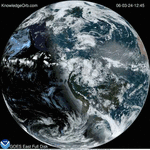The star Gliese 667C is now the best candidate for harboring habitable worlds.
(Source PHL @ UPR Arecibo) – Our Solar System has only one habitable planet, or maybe two if you count Mars’ past when liquid water was running on its surface. More than one potentially habitable planet per star has been a very rare event in the known stars with planets. The well-known star Gliese 581 might have two and just recently the Kepler Space Telescope discovered two in the star Kepler-62. Now a team of scientists, led by Guillem Anglada of the University of Göttingen, reports the discovery of a star with three potentially habitable worlds.

Gliese 667C is part of a nearby triple system of stars 22 light years away. The team discovered that Gliese 667C has six planets, or even more, with three of them in the habitable zone and not much more massive than Earth. Gliese 667C is now the most interesting object for studying stellar systems with the potential for life.
About one hundred exoplanets, of the 898 detected so far, orbit their star at the right distance to sustain liquid water or the so-called ‘habitable zone’. However, most are big Jupiter-like worlds that are unable anyway to have a surface with liquid water. Only a few probably have the right size to be rocky worlds just like Earth.

Gliese 667C is the fourth known planetary system with at least six confirmed planets (Kepler-11, HD 10180, and HD 40307 also have six planets). Gliese 667C f and e will be added to the Habitable Exoplanets Catalog, now having a dozen objects of interest. Gliese 667C c was already added last year.












